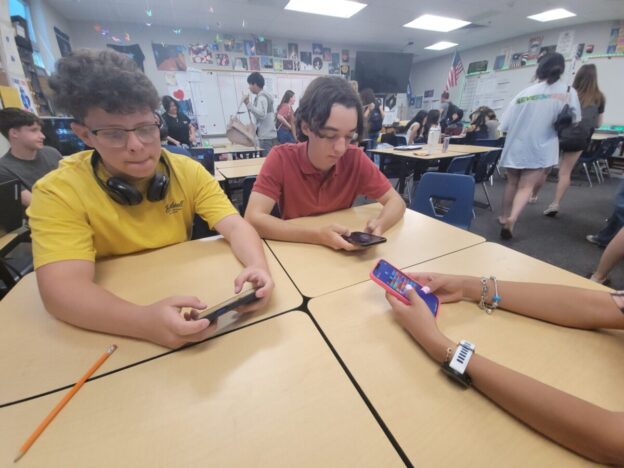Teachers at Redwood High School talk about the phone epidemic and how it affects students in and out of the classroom.
By: Sophia Rodriguez
The unrestricted use of smartphones can lead to distractions, addiction, cyberbullying, and an increase in anxiety, depression, and suicide. Schools can help limit that if they implement a rule to prevent students from being on their phones on campus.
On September 23, 2024, California Governor Gavin Newsom signed Assembly Bill 3216, also known as the Phone-Free School Act. This act requires the school district, county office of education, and charter schools to implement a rule limiting or prohibiting the use of phones at a school site under the supervision or control of school employees. Each school in California must adopt this Act by July 1st, 2026, and update the policy every five years.
Parents want their children to have instant access to their phones in an emergency. However, if every student rushes to their phone during an emergency, it could slow down the signal in the area and cause a delayed response to first responders. So the more safety policies schools put on phones, the safer students would be in an emergency.
Parents don’t want their kids’ phones taken in case of an emergency, but teachers believe the opposite.
Phones are “the largest distraction [for] students I’ve ever seen in my life. I think they take away from the learning experience on a multitude of levels. I cannot express to you how bad I think they are for the classroom environment,” says Mr. Adam Johnson, ’89, a Redwood alumnus who teaches English 2 and American Literature.

Photo Gigantea
Johnson believes that “within three or four years, phones will be banned from [Redwood].”
While today’s phone use can be a permanent shift in education, Johnson says “I think there is going to be a shift back to where [the phones] aren’t even in the classroom anymore but again it’s going to be a cops and robbers sort of thing because the students are going to figure out a way around it. I would suppose most students are going to have burner phones to turn in and they’ll have the real one on them.”
“The students will outsmart it and it’s a never-ending cycle.”
Johnson says he will apply a stricter rule against phones next year, but as of this year, he says he has “a three-step tier. If you get caught on the phone the first time, you have to put it in my white box. The second time, you have to put it in the white box while I collect it for three weeks. The third time it goes in the white box as you enter the room for the rest of the year, and we take it up with the admin and go from there.”
“Nobody at the time was in this situation, everybody has been pretty good since I implemented that rule. [One of my classes] has gotten a lot better, but I’d be stupid to think that I’ve stopped it completely. I don’t have 30 sets of eyes, and I can’t watch everybody at all times. Some people, I think, have gotten better at hiding it,” says Johnson.
“Banning phones on campus with the pushback from parents is part of the problem, and the students take advantage of it,” says Johnson.
“Students for sure use that as an excuse. ‘It’s my mom’ Well I don’t care if it’s your God, I don’t want the phone in here. That’s why, as part of my phone policy back at the beginning of the year, I asked parents not to contact [their kids], but I also can’t tell them not to because there are instances of emergency. For the most part, if the parents are on board, we should be good, like most things,” says Johnson.
Phones can be addicting and cause a release of dopamine every time you check your phone. Dopamine is a hormone released in the brain to make you “feel good.” This hormone plays a crucial role in motor functions for your body and affects attention, focus, learning, and memory, which is why some experts suppose phones and any technology are a threat.
Johnson says, “There is a lot of science behind the dopamine rush people get, everybody, not just students, myself included, from the phone and that constant feedback, that constant kick of dopamine. So it’s hard to compete with that. They adversely affect students’ learning because they distract them, and they’re not paying attention to simple things like lessons and directions.”
“So if I allowed students to be on their phones the whole time, I couldn’t imagine how many times I’d have to reiterate directions. By eliminating [phones], hopefully, students will pay more attention to the learning process, I cross my fingers.”
“I think it’s a real addiction among everybody,” says Johnson. “Most of the teachers have problems with it, too. I know you have classes where your teacher has that phone out all the time. I have friends of mine on campus who don’t want to enforce phone rules in their classrooms because they are on their phones. They say ‘because that’s not fair, I have to model that.”
“Sometimes I get a little selfish, and I try to remind [my students] because of this, I want you here, I want you on time, and I want you focused, because we can learn when that happens and ultimately that’s the best thing for you and that’s what I want. The best outcomes for you guys, and when you succeed, I succeed. These are just obstacles, and sometimes we have to just remove them,” says Johnson.
Johnson says he can’t let himself get emotional over students using their phones during instructional time and has learned to no longer take it personally, and instead has implemented rules for students that have consequences. He says, “In most interactions in class, when students are negative towards the teacher, it isn’t personal; it’s very rarely about the teacher, it’s something else that’s been bothering them. So, as much as the case with the phone, they’re addicted to that phone; I’m just an obstacle in the way of getting to that addiction.”
“They want that dopamine, they want to get on there and get that instant feedback with that 10 – 20 second TikTok stimulation. So they don’t hate Adam Johnson, they hate that obstacle, and they need that [phone]. That’s the best way to handle it. It’s not personal; they know the rules, they signed the contract, and it just gets handled. And then for sure they don’t take it personally either, I’m not picking on them, it’s just part of the rules, and we all agreed to it. But I don’t like it when people ignore it,” says Johnson.
“The stricter I get, the more savvy students get,” says Johnson about enforcing phone policies in the classroom. “Usually, when a student gets caught looking down between their legs, or I sit them somewhere where I can see them more, they will get craftier on how to get to their phone. I can’t keep an eye on everybody all at once, which stinks, as a student. For instance, in [one of my classes, an anonymous student], I’m always watching them because I’ve caught them on it before. Now my attention to [anonymous student] takes away from maybe somebody else.”
“So [anonymous student] may say, ‘Well, that stinks. I’ve seen someone else on their phone three times today and you didn’t say anything.’ Well, yeah, because I’ve caught you on yours, so my attention is on you. So that problem is big because I can’t watch everyone at once and it creates that idea in people’s heads that I’m picking on them but I’m not, I’m just trying to catch everybody on their phones, but also then too that takes away from my feedback and ability to teach you things because I’m worried about phones when I should be focused on the lesson,” says Johnson.
“Positive outcomes from my students are the most important thing and those phones just hinder that,” says Johnson.
Mr. David Clements, ’92, who teaches English 2, ERWC, and is the defensive coordinator on the varsity football team, and has taken a much more relaxed approach to phones, says he “prefers to be flexible because I feel like if I was super strict about [phones], it would just be a major distraction for me and I would just obsess on it and the way I am with student discipline. As strict as I can be, that approach would get really ugly in class, and I just would rather not fight that fight. Hopefully, students are mature about it and use it wisely, and they’re not distracted by their phones.”
While Clements says he prefers a flexible approach for phones, he also has implemented a time when students should and should not have their phones out. He says, “Honestly, I don’t want them out at all, but I have a hard time if I spend all my time focusing on phones. It turns into a disciplinary situation, and then that’s trouble too. What I do is, at the beginning of each semester, I have a conversation about the right and wrong ways to use the phone, and I hope that students are smart about when they use their phones.”
“I allow them to be face down on the top of their desk, but I do not allow them to pick them up and have them in front of their eyes. If they do use it, it has to be very quickly and briefly. It’s not that I’m completely allowing the full use of phones, but I guess I’m not nearly as strict as other teachers,” says Clements.
Phones can affect the eyes, brain, mind, and a person’s way of thinking. Real and virtual can blur a student’s mind and create confusion between what is real and what is fake. They cause a high issue of a loss of focus in the classroom, which can lead to an affected grade.
Clements says, “For some students, [phones] have a negative effect on [them]. I think to a certain degree, all of us now have a phone addiction that we’re all fighting and battling because they’re such a big part of our lives. [If there were], from a district standpoint, a stricter rule to back me up [about phones], then I would be completely willing to take phones out of the classroom. But those aren’t policies that are being handed down to me, so I guess I have a little more of a relaxed approach because [of it].”
“I think phone addiction is real for all of us, and I think it’s getting worse and worse. So that’s why I try to teach smart use of phones instead of trying to outlaw them, because students like sneaking around, and I think that’s silly. I don’t want that happening in my room. I don’t want to fight that battle with them. I hope that they’re mature about it and they handle it in the right way,” says Clements.
When students choose to ignore the rules in the classroom, Clements says, “I think in general, if a teacher is lecturing or a teacher has asked for certain activities to be happening in class, and you’re completely distracted by your phone, it’s rude. That’s what I’m kind of leaning on more than anything. Moving forward, I know that students will navigate their phones in the workplace, and some jobs do not allow their phones out at all. What I’m trying to do is teach my students common sense about the proper use of phones and the manners that go along with that.”
“I think [phones are] not going away, and if anything, they are going to be an even bigger part of our lives, and so to me, I think it’s an all-or-nothing approach,” says Clements about whether phones will be a permanent shift in education or just a phase.
Clements says, “I know some schools have hanging bags in the front where kids drop their phones off before the class, and there are a lot of different approaches. I know that for the younger students in elementary and junior high, it’s a zero-tolerance policy where those phones, like my son’s, a sixth grader, and his phone can’t ever come out of his backpack, and it has to stay there.
Clements says, “I think if our school had a ‘phones must stay away inside of class’ hard rule that everybody was following, I would gladly follow that rule, but because we don’t have that, I’m unwilling to create a stricter rule than what is being passed down to me.”
Tags: cellphones, phones, rangers, Redwood, redwood gigantea, redwood high school, redwood journalism, redwood phones, redwood rangers, redwood teachers, rhs, rhs phones, teachers


